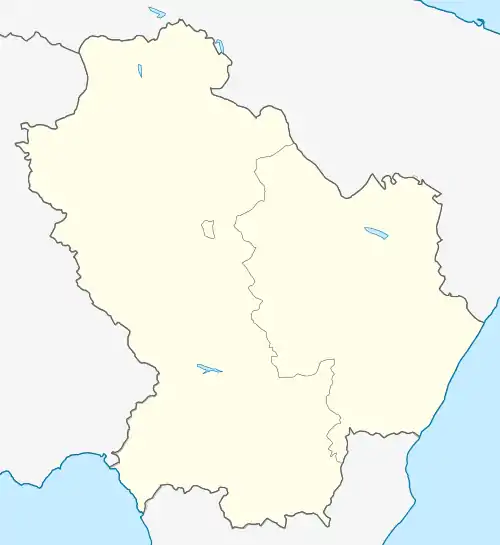Lavello | |
|---|---|
| Città di Lavello | |
 | |
 Coat of arms | |
Location of Lavello | |
 Lavello Location of Lavello in Italy  Lavello Lavello (Basilicata) | |
| Coordinates: 41°3′N 15°48′E / 41.050°N 15.800°E | |
| Country | Italy |
| Region | Basilicata |
| Province | Potenza (PZ) |
| Frazioni | Gaudiano |
| Government | |
| • Mayor | Antonio Annale |
| Area | |
| • Total | 132 km2 (51 sq mi) |
| Elevation | 313 m (1,027 ft) |
| Population (September 2008)[2] | |
| • Total | 13,871 |
| • Density | 110/km2 (270/sq mi) |
| Demonym | Lavellesi |
| Time zone | UTC+1 (CET) |
| • Summer (DST) | UTC+2 (CEST) |
| Postal code | 85024 |
| Dialing code | 0972 |
| Patron saint | San Mauro |
| Saint day | 2 May |
| Website | Official website |
Lavello (Potentino: Lavìdde) is a town and comune in the province of Potenza, in the region of Basilicata of southern Italy; it is located in the middle Ofanto valley.
History
The area of Lavello was settled in prehistoric times, as attested by findings of an Iron Age village. The town originated as a Daunian and then Roman settlement, known as Forentum. It was already an important stronghold during the Lombard rule in southern Italy, and here was killed Sicard of Benevento (839).
Lavello was an important Byzantine center and a bishopric seat from 1025. Starting from 1043 Lavello was one of the twelve baronies of the Norman county of Apulia in southern Italy. The Normans rebuilt the cathedral and added a line of walls. The fortress was strengthened under their successors, the Hohenstaufen. Here King Conrad IV of Germany died in 1254. As a result of its participation in the anti-Angevine revolt in 1268, it was burnt down by Charles I of Anjou in 1298.
Main sights
- The Castle
- Church of Annunziata (17th century), housing a 16th-century Annunciation from the Neapolitan School.
Famous citizens
- Angelo Tartaglia - mercenary
Notes and references
- ↑ "Superficie di Comuni Province e Regioni italiane al 9 ottobre 2011". Italian National Institute of Statistics. Retrieved 16 March 2019.
- ↑ "Popolazione Residente al 1° Gennaio 2018". Italian National Institute of Statistics. Retrieved 16 March 2019.